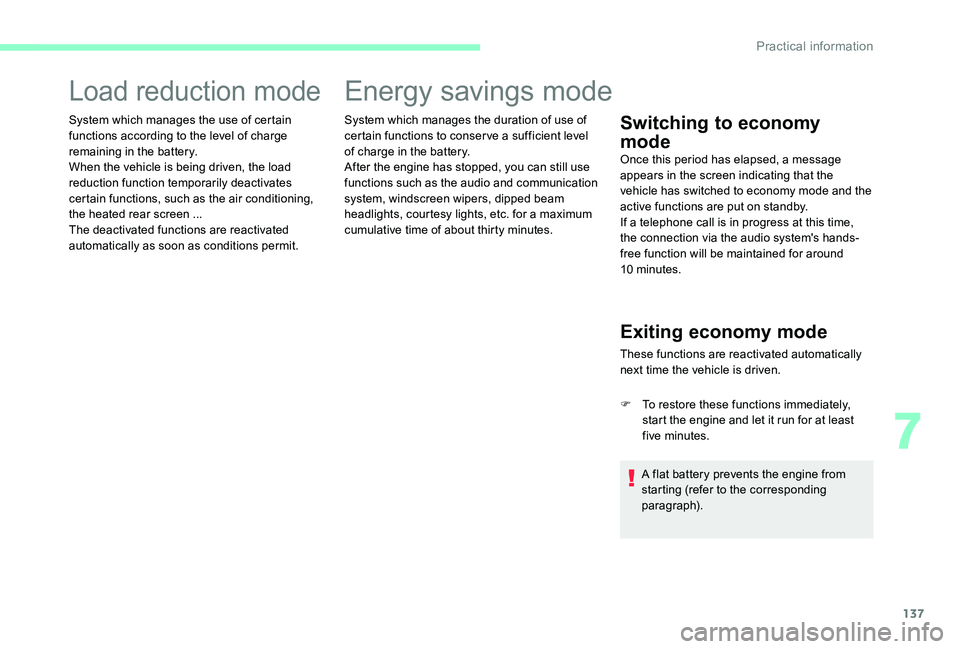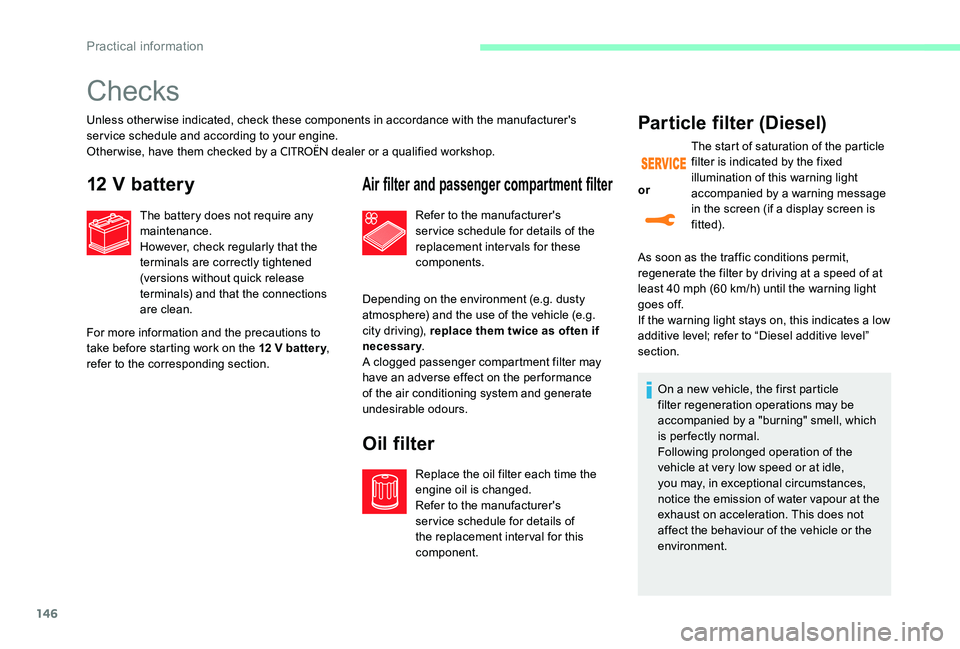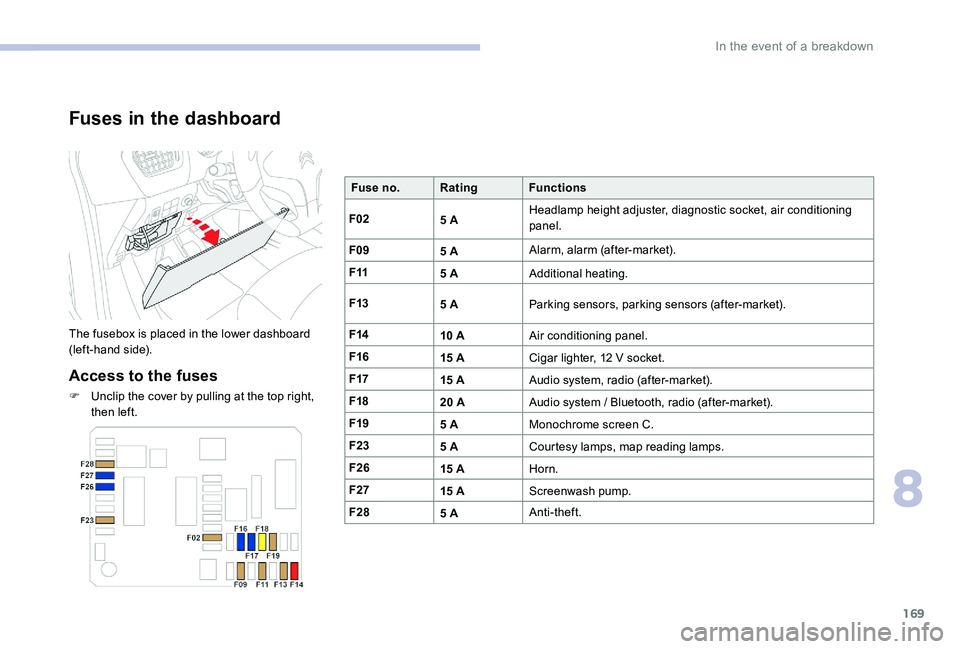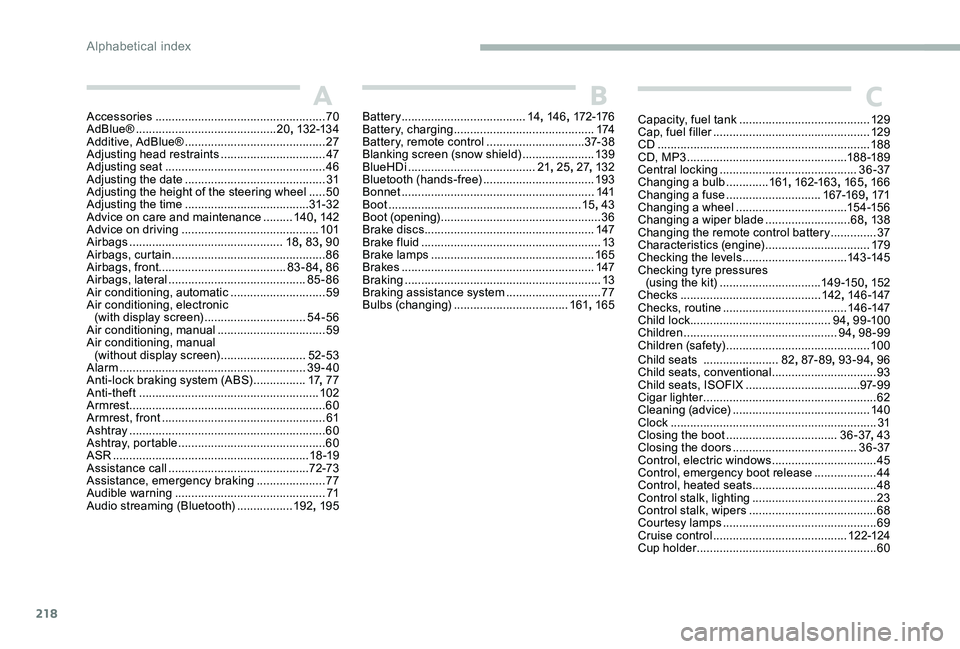air condition CITROEN C-ELYSÉE 2017 Handbook (in English)
[x] Cancel search | Manufacturer: CITROEN, Model Year: 2017, Model line: C-ELYSÉE, Model: CITROEN C-ELYSÉE 2017Pages: 306, PDF Size: 9.34 MB
Page 61 of 306

59
Recommendations for heating, ventilation and air conditioning
In order for these systems to be fully
effective, follow the operation and
maintenance guidelines below:
F
T
o ensure that the air is distributed
evenly, keep the external air intake
grilles at the base of the windscreen, the
nozzles, the vents, the air outlets and
the air extractor located in the back free
from obstructions.
F
O
perate the air conditioning system for
at least 5 to 10 minutes, once or twice a
month to keep it in per fect working order.
F
E
nsure that the passenger compartment
filter is in good condition and have the
filter elements replaced regularly.
We recommend the use of a combined
passenger compartment filter. Thanks to its special active additive, it contributes
to the purification of the air breathed by
the occupants and the cleanliness of the
passenger compartment (reduction of
allergic symptoms, bad odours and greasy
deposits).
F
T
o ensure the correct operation of the
air conditioning system, you are also
advised to have it checked regularly as
recommended in the maintenance and
warranty guide.
F
I
f the system does not produce cold
air, switch it off and contact a
CITROËN
dealer or a qualified workshop.
When towing the maximum load on a steep
gradient in high temperatures, switching off
the air conditioning increases the available
engine power and so improves the towing
ability. If after an extended stop in sunshine,
the interior temperature is very
high, first ventilate the passenger
compartment for a few moments.
Put the air flow control at a setting high
enough to quickly change the air in the
passenger compartment.
The air conditioning system does not
contain chlorine and does not present
any danger to the ozone layer.
The condensation created by the air
conditioning results in a discharge of
water under the vehicle which is per fectly
normal.
Stop & Star t
The heating and air conditioning systems
only work when the engine is running.
To maintain a comfortable temperature
in the passenger compartment, you can
temporarily deactivate the Stop & Start
system.
For more information on Stop & Star t , ,
refer to the corresponding section.
3
Ease of use and comfort
Page 76 of 306

74
Tyre under-inflation detection
System which automatically checks the
pressures of the tyres while driving.
The system monitors the pressures in the four
tyres, once the vehicle is moving.
It compares the information given by the four
wheel speed sensors with reference values,
which must be reinitialised ever y time the
tyre pressures are adjusted or a wheel
changed.
The system triggers an alert as soon as it
detects a drop in the inflation pressure of one
or more tyres.Under-inflation alert
The under-inflation detection system does
not replace the need for vigilance on the
part of the driver.
This system does not avoid the need to
check the tyre pressures (including the
spare wheel) every month as well as
before a long journey.
Driving with under-inflated tyres worsens
road-holding, lengthens braking distances,
causes premature wear of the tyres,
particularly in adverse conditions (heavy
loads, high speeds, long journeys). Driving with under-inflated tyres
increases fuel consumption.
The inflation pressures defined for your
vehicle can be found on the tyre pressure
label.
For more information on the
Identification markings , refer to the
corresponding section.
Checking tyre pressures
This check should be done when the tyres
are "cold" (vehicle stopped for 1 hour or
after a journey of less than 6 miles (10 km)
at moderate speeds).
Other wise, add 0.3 bar to the pressures
shown on the label. This warning is indicated by
continuous illumination of the light,
an audible signal and a message
displayed on the screen.
F
R
educe speed immediately, avoid
excessive steering movements and sudden
braking.
F
S
top as soon as it is safe to do so.
The loss of pressure detected does not
always cause visible bulging of the tyre.
Do not rely on a simple visual check.
F I f you have a compressor (such as the
one in the temporary puncture repair kit),
check the pressures of the four tyres when
cold. If it is not possible to make this check
immediately, drive carefully at reduced
speed.
or
F
I
n the event of a puncture, use the
temporary puncture repair kit or the spare
wheel (depending on equipment).
The warning remains active until the
system is reinitialised.
Safety
Page 81 of 306

79
Operating fault
Illumination of this warning lamp,
accompanied by the display of a
message and an audible signal,
indicates a fault with the system.
Contact a
CITROËN dealer or a qualified
workshop to have the systems checked.
ASR / DSC
Reactivation
The ASR system is reactivated automatically
every time the ignition is switched back on or
from 30 mph (50 km/h).
Below 30 mph (50 km/h), you can reactivate it
manually.
F
P
ress this button again to
reactivate the system manually.
The button indicator light goes off. These systems offer increased safety
in normal driving, but they should not
encourage the driver to take extra risks or
drive at high speed.
It is in conditions of reduced grip (rain,
snow, black ice) that the risk of loss of grip
increases. For your safety, you should
therefore keep these systems activated at
all times, particularly in poor conditions.
The correct operation of these
systems depends on observation of
the manufacturer's recommendations
regarding both the wheels (tyres and
rims), braking and electronic components
and the assembly and repair procedures
used by
CITROËN dealers.
In order to benefit from the efficiency of
these systems in winter conditions, we
recommend using snow tyres.
In this case, it is essential to equip the
four wheels with tyres approved for your
vehicle.
5
Safety
Page 85 of 306

83
Air bags
Designed to contribute to the safety of the
occupants in case of violent collisions The
airbags supplement the action of the force-
limiting seat belts.
If a collision occurs, the electronic detectors
record and analyse the front and side impacts
sustained in the impact detection zones:
-
I
n the event of violent impact, the air
bags are deployed instantly and help
better protect occupants of the vehicle;
immediately after the impact, the air
bags deflate rapidly in order not to hinder
the visibility nor the possible exit of the
occupants.
-
I
n the event of a non violent impact, impact
on the back and under certain conditions of
a rollover, the air bags may not deploy; only
the seat belt helps to protect you in these
situations.
The air bags do not operate when the
ignition is switched off.Impact detection zones Front air bags
This equipment will only deploy once. If a
second impact occurs (during the same or
a subsequent accident), the airbag will not
be deployed again. The deployment of an air bag is
accompanied by a slight emission of
smoke and a noise, due to the detonation
of the pyrotechnic charge incorporated in
the system.
This smoke is not harmful, but sensitive
individuals may experience slight irritation.
The detonation noise associated with the
deployment of an air bag may result in a
slight loss of hearing for a short time.
A
Front impact zone.
B Side impact zone. System which protects the driver and front
passenger in the event of a serious front impact
in order to limit the risk of injury to the head and
thorax.
The driver's air bag is fitted in the centre of the
steering wheel; the front passenger's air bag is
fitted in the dashboard above the glove box.
5
Safety
Page 139 of 306

137
Load reduction mode
System which manages the use of certain
functions according to the level of charge
remaining in the battery.
When the vehicle is being driven, the load
reduction function temporarily deactivates
certain functions, such as the air conditioning,
the heated rear screen ...
The deactivated functions are reactivated
automatically as soon as conditions permit.
Energy savings mode
System which manages the duration of use of
certain functions to conserve a sufficient level
of charge in the battery.
After the engine has stopped, you can still use
functions such as the audio and communication
system, windscreen wipers, dipped beam
headlights, courtesy lights, etc. for a maximum
cumulative time of about thirty minutes.Switching to economy
mode
Once this period has elapsed, a message
appears in the screen indicating that the
vehicle has switched to economy mode and the
active functions are put on standby.
If a telephone call is in progress at this time,
the connection via the audio system's hands-
free function will be maintained for around
10
minutes.
Exiting economy mode
These functions are reactivated automatically
next time the vehicle is driven.
F
T
o restore these functions immediately,
start the engine and let it run for at least
five minutes.
A flat battery prevents the engine from
starting (refer to the corresponding
paragraph).
7
Practical information
Page 148 of 306

146
Checks
Unless otherwise indicated, check these components in accordance with the manufacturer's
service schedule and according to your engine.
Other wise, have them checked by a
CITROËN dealer or a qualified workshop.
12 V battery
For more information and the precautions to
take before starting work on the 12 V batter y,
refer to the corresponding section. The battery does not require any
maintenance.
However, check regularly that the
terminals are correctly tightened
(versions without quick release
terminals) and that the connections
are clean.
Air filter and passenger compartment filter
Depending on the environment (e.g. dusty
atmosphere) and the use of the vehicle (e.g.
city driving), replace them twice as often if
necessary
.
A clogged passenger compartment filter may
have an adverse effect on the per formance
of the air conditioning system and generate
undesirable odours. Refer to the manufacturer's
service schedule for details of the
replacement intervals for these
components.
Oil filter
Replace the oil filter each time the
engine oil is changed.
Refer to the manufacturer's
service schedule for details of
the replacement interval for this
component.
Particle filter (Diesel)
As soon as the traffic conditions permit,
regenerate the filter by driving at a speed of at
least 40 mph (60 km/h) until the warning light
goes off.
If the warning light stays on, this indicates a low
additive level; refer to “Diesel additive level”
section. or
The start of saturation of the particle
filter is indicated by the fixed
illumination of this warning light
accompanied by a warning message
in the screen (if a display screen is
fitted).
On a new vehicle, the first particle
filter regeneration operations may be
accompanied by a "burning" smell, which
is per fectly normal.
Following prolonged operation of the
vehicle at very low speed or at idle,
you may, in exceptional circumstances,
notice the emission of water vapour at the
exhaust on acceleration. This does not
affect the behaviour of the vehicle or the
environment.
Practical information
Page 170 of 306

168
Changing a fuse
The replacement of a fuse not shown in
the tables below may cause a serious
malfunction of your vehicle. Contact a
CITROËN dealer or a qualified workshop.
If the fuse fails again soon after
replacement, have the vehicle's electrical
system checked by a
CITROËN dealer or a
qualified workshop. Good
Failed
Pliers
Before changing a fuse:
F
T
he cause of the failure must be identified
and rectified.
F
A
ll devices consuming electricity must be
switched off.
F
T
he vehicle must be immobilised with the
ignition off.
F
I
dentify the defective fuse using the
existing allocation tables and diagrams
given in the following pages.
To replace a fuse, you must:
F
U
se the special tweezers to extract the
fuse from its housing and check the
condition of its filament.
F
A
lways replace the failed fuse with a fuse
of the same rating (same colour); using a
different rating could cause faults (risk of
f i r e). Installing electrical accessories
Your vehicle's electrical system is
designed to operate with standard or
optional equipment.
Before installing other electrical
equipment or accessories on your vehicle,
contact a
CITROËN dealer or a qualified
workshop.
CITROËN will not accept responsibility for
the cost incurred in repairing your vehicle
or for rectifying malfunctions resulting
from the installation of accessories
not supplied and not recommended by
CITROËN and not installed in accordance
with its instructions, in particular when
the combined consumption of all of the
additional equipment connected exceeds
10 milliamperes.
In the event of a breakdown
Page 171 of 306

169
Fuses in the dashboard
The fusebox is placed in the lower dashboard
(left-hand side).
Access to the fuses
F Unclip the cover by pulling at the top right, then left. Fuse no.
Rating Functions
F02 5 AHeadlamp height adjuster, diagnostic socket, air conditioning
panel.
F09 5 AAlarm, alarm (after-market).
F11 5 AAdditional heating.
F13 5 AParking sensors, parking sensors (after-market).
F14 10 AAir conditioning panel.
F16 15 ACigar lighter, 12 V socket.
F17 15 AAudio system, radio (after-market).
F18 20 AAudio system / Bluetooth, radio (after-market).
F19 5 AMonochrome screen C.
F23 5 ACourtesy lamps, map reading lamps.
F26 15 AHorn.
F27 15 AScreenwash pump.
F28 5 AAnti-theft.
8
In the event of a breakdown
Page 173 of 306

171
Fuse in the engine
compartment
The fusebox is placed in the engine
compartment near the battery (left-hand side).
Access to the fuses
F Unclip the cover
F C hange the fuse.
F
W
hen you have finished, close the cover
very carefully to ensure correct sealing of
the fusebox. Fuse no.
Rating Functions
F14 15 AHeated lower windscreen.
F15 5 AAir conditioning compressor.
F16 15 AFront fog lamps.
F18 10 A
Right-hand main beam headlamp.
F19 10 A
Left-hand main beam headlamp.
F29 40 A
Front wiper motor.
F30 80 APre-heater plugs (Diesel).
8
In the event of a breakdown
Page 220 of 306

218
Accessories .................................................... 70
AdBlue® ................ ...........................20, 132-13 4
Additive, AdBlue®
........................................... 2
7
Adjusting head restraints
................................47
Adjusting seat
................................................. 46
Adjusting the date
........................................... 31
Adjusting the height of the steering wheel
.....50
Adjusting the time
...................................... 31- 32
Advice on care and maintenance
.........140, 142
Advice on driving
.......................................... 101
Airbags
...............................
................18, 83 , 90
Airbags, curtain
............................................... 86
Airbags, front ....................................... 83-84, 86
Airbags, lateral
.......................................... 85-86
Air conditioning, automatic
.............................59
Air conditioning, electronic (with display screen)
...............................54-56
Air conditioning, manual
................................. 59
A
ir conditioning, manual
(without display screen)
..........................52-53
Alarm
......................................................... 39-40
Anti-lock braking system (ABS)
................17, 77
Anti-theft
....................................................... 102
Armrest
................
............................................ 60
Armrest, front
.................................................. 61
Ashtray
...............
............................................. 60
Ashtray, portable
............................................. 60
ASR
........
.................................................... 18 -19
Assistance call
...............................
............72-73
Assistance, emergency braking
.....................77
Audible warning
.............................................. 71
A
udio streaming (Bluetooth)
.................192, 195 Battery
......................................14, 146 , 172-176
Battery, charging
...........................................174
Battery, remote control
..............................37- 3 8
Blanking screen (snow shield)
......................13 9
BlueHDi
.......................................21, 25 , 27, 132
Bluetooth (hands-free)
.................................. 19
3
Bonnet
...........................................................141
Boot
...........................................................15, 43
Boot (opening)
...............................
..................36
Brake discs
....................................................147
Brake fluid
.......................................................13
Brake lamps
...............................
...................165
Brakes
...........................................................147
Braking
...............
.............................................13
Braking assistance system
.............................77
Bulbs (changing)
...................................161, 165
Child seats
.......................8
2, 87- 8 9 , 93-94 , 96
Child seats, conventional
................................93
Child seats, ISOFIX
...................................97- 9 9
Cigar lighter
.....................................................62
Cleaning (advice)
..........................................140
Clock
...............................................................31
Closing the boot
..................................36 -37, 43
Closing the doors
......................................36 -37
Control, electric windows
................................45
Control, emergency boot release
...................44
Control, heated seats
......................................48
Control stalk, lighting
......................................23
Control stalk, wipers
.......................................68
C
ourtesy lamps ...............................................69
Cruise control
.........................................12 2-124
Cup holder
.......................................................60ABC
Capacity, fuel tank ........................................ 129
Cap, fuel filler ............................... .................129
CD
................................................................. 188
CD, MP3
................................................. 188 -189
Central locking
.......................................... 3
6 -37
Changing a bulb
............. 16
1, 162-163 , 165, 166
Changing a fuse
............................. 16
7-169, 171
Changing a wheel
.................................. 15
4 -15 6
Changing a wiper blade
.......................... 68,
13 8
Changing the remote control battery
..............37
Characteristics (engine)
................................179
Checking the levels
................................ 143 -145
Checking tyre pressures (using the kit)
............................... 14 9 -15 0, 152
Checks
........................................... 142, 146 -147
Checks, routine
...................................... 146 -147
Child lock
........................................... 94, 9 9 -10 0
Children
............................................... 94, 98-99
Children (safety)
............................................ 10 0
Alphabetical index